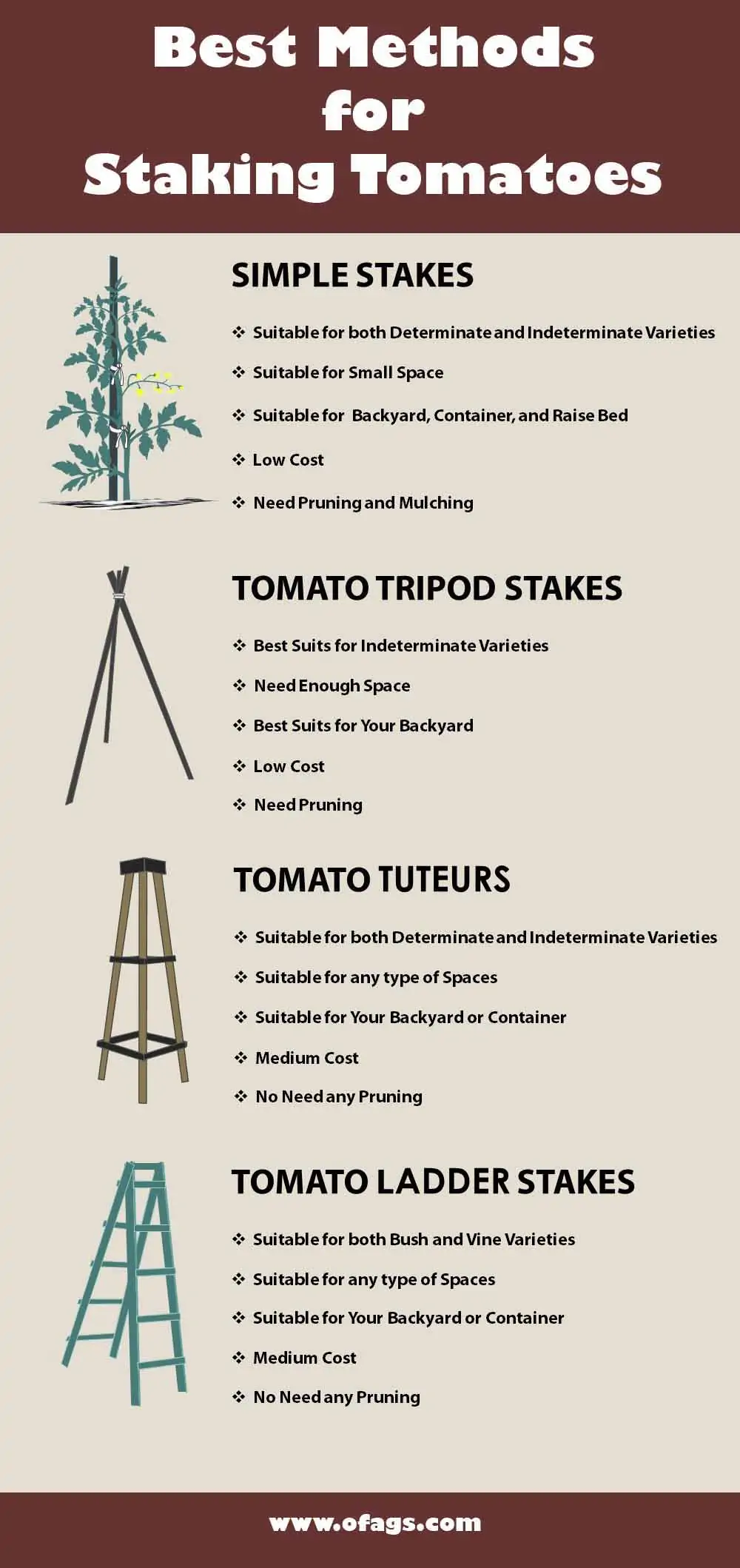Staking tomato plants is an art. However, perfect staking for your garden tomatoes shows your expertise in this field and ensures a healthy harvest.
There are plenty of ways and design to stake tomato plants, but concentrating on the following factors help you to get the best output.
Tips# 1: Staking your tomato plants based on varieties
Tomato variety is the most critical factor in choosing the proper staking methods. Different varieties need different staking methods, and their size may also be unlike.
So, confirm the varieties before planting tomatoes. Tomato seed packets and plant tags indicate the type of tomato varieties, average plant height, fruit size, growing season, disease resistance code, and other information.
Determinate tomatoes
Determinate tomato varieties need low-height staking or caging around 4 to 5-foot long and 1-inch diameter. Set the stake at best 12 inches deep into the soil. If you use a tripod stake, then set the legs of the tripod to stand around 4 to 5 inches deep inside the ground.
Indeterminate tomatoes
Vine-type tomatoes need longer wooden stakes, around 8 to 9 inches tall and 1 to 1.5 inches thick. You can also use similar sizes of bamboo sticks for staking tomatoes. Bamboo stakes are usually stronger than wooden stakes.
Indeterminate tomato stakes need to be set deeper into the ground, around 18 inches, to hold the extra load of the plant leaves and fruits.
Semi-determinate tomatoes
Semi-bush or semi-determinate tomato varieties usually need 4 to 5-foot tall stakes or cage-like determinate tomatoes.
Tips# 2: Choose suitable materials for staking tomatoes
Select the right materials to use for staking your tomatoes. You can use some materials for making your tomato stakes, such as a thick wooden stake, bamboo stake, or rebar.
Before using the wooden or bamboo stake, ensure those materials are not treated chemically.
The height and thickness of the stake depend on the type of tomato variety. Indeterminate tomato varieties need longer and sturdier stakes than determinate tomato varieties.
Besides, if you are budget conscious, choose bamboo or wooden stake over rebar because they are more costly but last longer.
Tips# 3: Select the right time for staking tomato plants
I recommend staking your tomatoes during the transplant. Because staking tomato plants during the growing season may damage the root system. Besides, staking tomatoes earlier help them to stand firm without touching the ground and protect them from soil-borne fungal diseases.
So, set up the stakes according to your plant varieties initially. Then, after finishing the transplant, push a stake close to each tomato plant deep into the soil to train them up. Staking your tomatoes during transplants will give you the best output.
Tips# 4: Best methods for staking tomatoes
The best tomato staking method may depend on some factors. And, it may be an exception for you from other gardeners. So, there is no specific best method before confirming the following factors:

Tomato varieties:
Indeterminate or vine-type tomatoes perform better with simple staking, the Tripod, Tuteurs, or tomato ladder methods. Besides, some varieties are also comfortable with wire trellising or tomato tower cages.
On the other hand, determinate or bush-type tomato varieties like Florida weave trellis, tomato caging, fencing, and sometimes low-height simple staking.
However, semi-determinate tomatoes prefer the vine-type staking methods and bush-type methods, which also suit them.
Space:
Your garden location and space also may vary the tomato staking methods. If you have a backyard and enough place, you can follow any staking method you wish. Moreover, you can also pick any tomato variety.
But if you have limited space on your balcony, rooftop, or other places, follow staking methods that take a short distance to set up.
Cost:
If you have a limited budget, follow those methods which are less expensive. But if the budget doesn’t matter, you can choose any varieties which last longer, are lucrative, and are made from heavy materials.
Containers and raised bed:
Container tomatoes are usually busy type and best suited for caging methods. However, simple staking and wire trellising methods also work for containers, buckets, growing bags, and potting tomatoes.
Raise bed prefers tomato caging. Also, trellising and Florida wave methods work to raise beds.
